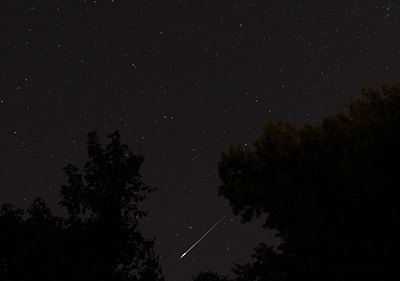
Oct 17
Orionid Meteor Shower: Leftovers of Halley’s Comet | Space.com

Image Credit: Dan Brandon
The Orionid meteor shower takes place in October and November each year, peaking in mid-October. The Orionids are noted for being bright and quick fragments, according to NASA, with an average speed of about 148,000 mph (238,000 kph). However, this year’s shower, predicted for the night of Oct. 20-21, may be spoiled by moonlight.
The Orionids, like all meteor showers, are named after the constellation in which they appear to come from, which in this case is Orion the Hunter. While the constellation is best visible in the Northern Hemisphere, the meteor shower is visible in both the northern and southern hemispheres. Orion’s location is:
Right ascension: 5 hours
Declination: 5 degrees
Latitudes: Between 85 and -75 degrees
“The Orionids are also framed by some of the brightest stars and planets in the night sky, which lend a spectacular backdrop for these showy meteors,” NASA wrote on a web page about the annual shower.
via Orionid Meteor Shower: Leftovers of Halley’s Comet | Space.com.
Oct 15
Neptune Shines In Night Sky This Week | Space.com

Neptune’s winds travel at more than 1,500 mph, and are the fastest planetary winds in the solar system.
CREDIT: NASA/JPL
Neptune is much too faint to be seen with the unaided eye, but right now you can see the blue planet shine just by using binoculars.
Neptune lies an average distance of 2.8 billion miles (4.5 billion km) from the sun. With the demotion of Pluto to dwarf planet status, Neptune is now the farthest of the “classical” planets in the solar system. It is slightly smaller than Uranus, with a diameter of 30,775 miles (49,528 km).
Currently at magnitude +7.8, it’s more than six times dimmer than Uranus. Nonetheless, if you have access to a dark, clear sky and carefully examine a good star map, y ou should have no trouble in finding it with binoculars. Neptune can be found among the stars of Aquarius which is about one-third of the way up from the southeast horizon to the point directly overhead (called the zenith) as darkness falls. With a telescope, trying to resolve Neptune into a disk will be more difficult than it is with Uranus. You’re going to need at least a 4 inch (10 centimeters) telescope with a magnification of no less than 200-power, just to turn Neptune into a tiny blue dot of light.

